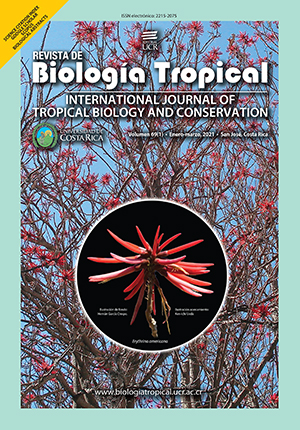Abstract
Introduction: The selection of day-roost is a crucial process for bats because it influences the ecology, social organization, and survivorship aspects of their populations. Proboscis bat (Rhynchonycteris naso) is a protected species by Mexican law, whose foraging and roosting areas are strongly associated with bodies of water, primarily rivers. Therefore, alterations in the water quality pose a risk to their populations. However, knowledge of the current state of their populations and roosting ecology is very poor in Mexico. Objectives: To locate and to describe R. naso's diurnal roosts, and to evaluate the relationship of the group size per roost with the characteristics of the diurnal roost, the salinity and pH of the water where they inhabit. Methods: From March to October 2015, we searched diurnal roost through boat tours along rivers, streams, and lagoons, in eleven sites in the Laguna de Términos Flora and Fauna Protection Area, Campeche, Mexico. For each localized roost, we recorded the group size, and their spatial distribution, the type of roost and vegetation, the distance between roosts, the diameter of trunk, the salinity, and pH. In order to investigate the effect of the variables recorded in diurnal roost on size group, generalized linear models were adjusted. Results: We found 48 diurnal roost in dead tree-trunks, tree bark and bridges, associated with freshwater, and oligohaline bodies, mainly in mangrove vegetation. The average size of the groups was 5.3 ± 0.48 and 22.6 ± 9.54 in natural and artificial roosts, respectively. We found a significant relationship with the type of roost, type of vegetation and diameter of trunk. Roosts with larger groups of bats presented an aggregated distribution. We located 40 diurnal roosts on freshwater bodies and eight in oligohaline with a high grouping level. Conclusions: Greater incidence of roost in fresh and lightly acid water is explained under optimal foraging theory. Because the study area is found in the limit of their distribution, mangrove is a very important vegetation type to guarantee the establishment of R. naso populations. Also, due no roosts were found in some portions of the study zone, quality of water, and contaminant level studies are crucial. This study provides relevant information on their populations with direct implications for the conservation in coastal areas.

This work is licensed under a Creative Commons Attribution 4.0 International License.
Copyright (c) 2021 Karla P. Borges-Jesús, M. en C., José D. Cú-Vizcarra, M. en C., Griselda Escalona-Segura, Dra., Jorge A. Vargas-Contreras, Dr.


